The German Shepherd Rottweiler Mix, often called a Shepweiler, is a remarkable blend of two powerful and intelligent breeds. From my experience, this mix inherits the best of both worlds. They possess the loyalty and intelligence of German Shepherds and the strength and confidence of Rottweilers.
I remember a Shepweiler named Max I met at a charity event; his alertness and keen sense of surroundings were truly impressive. These dogs have a strong protective instinct, making them excellent family pets if socialized and trained properly. However, their size and energy levels mean they need plenty of exercise and space to thrive.
Above all, their versatility and adaptability to various roles, from companionship to working alongside professionals, never cease to amaze me. I want to tell you more about this breed below. Read on!
TABLE OF CONTENTS
- German Shepherd Rottweiler Mix Quick Breed Summary
- German Shepherd Rottweiler Mix Parent Breeds
- German Shepherd Rottweiler Mix Physical Characteristics
- German Shepherd Rottweiler Mix Personality and Temperament
- German Shepherd Rottweiler Mix Puppy
- German Shepherd Rottweiler Mix Care Guide
- German Shepherd Rottweiler Mix Health Issues
- FAQs on German Shepherd Rottweiler Mix
- An Intelligent and Trainable Hybrid
- Other German Shepherd and Rottweiler Mixes
German Shepherd Rottweiler Mix Quick Breed Summary
German Shepherd Rottweiler Mix Parent Breeds
From Adobe Stock
If you are looking for a smart and strong dog, who is loyal and loving, you need look no further.
Both the German Shepherd and Rottweiler have a bad reputation for being dangerous dogs, but, most miss the point here. Both breeds are trainable and will do whatever you ask them to which is why the police and military like them.
A well socialized, and well-trained, German Shepherd or Rottweiler can be the gentlest and most even-tempered dog.
Being a hybrid, the German Shepherd Rottweiler Mix is not recognized by any Kennel Clubs. They are however recognized as a Rottie Shepherd in the Designer Breed Registry.
This dog was bred as a companion dog, and as with any designer cross-breed, the hope is to in-breed positive qualities and characteristics and out-breed negative qualities and health issues.
To help us understand what that means, let’s take a look at the parent breeds.
German Shepherd
From Adobe Stock
Origin
Despite their current military and police work, the German Shepherd dog originated to herd sheep in Germany. They were bred for intelligence, strength, agility, stealth and an overall air of authority.
The German Shepherd’s popularity increased in the U.S. in the early 1900s, largely thanks to the adventures of Strongheart, and this breed has subsequently been cross-bred to produce many mixed breeds:
Unfortunately, soon after their rise in popularity, came the War and their popularity plummeted due to the German association. After a name change to American Alsatian, and its subsequent return, the German Shepherd is loved again, world over, being the second most popular dog in the U.S.
Physical Characteristics
Typically, they stand about 22 to 26 inches tall at the shoulder, and their weight usually falls between 50 to 90 pounds, with males being generally larger. Their most striking feature is their double coat, which can be a variety of colors, but most commonly black and tan. I’ve spent countless hours grooming Shepherds at the kennel, which is essential due to their heavy shedding, especially during the change of seasons. Their ears, always erect, give them an alert appearance, and their eyes are full of intelligence and curiosity.
Temperament and Behavior
The temperament of a German Shepherd is something that’s always fascinated me. They’re known for their confidence, intelligence, and loyalty. In my experience, they form incredibly strong bonds with their families, and they can be quite protective. This breed is highly trainable; they pick up commands and tasks quickly, which makes training a German Shepherd a rewarding experience for dedicated owners. However, they need regular mental and physical stimulation — a bored German Shepherd can become restless and destructive.
Socialization is key from a young age, as they can be wary of strangers and other animals. Despite their sometimes intimidating appearance, they’re often affectionate and playful with their loved ones, displaying a gentler side that’s just as integral to their personality.
Rottweiler
From Adobe Stock
Origin
Much like the German Shepherd, the Rottweiler is adored for its intelligence and trainability too; another fastidious worker.
Originating in Germany, they were strong drover dogs. Their livestock careers soon ended with the advent of railroad cattle cars, but their versatility was noted. Since the early 1900s, Rotties have been solid workers working as guide dogs for the blind, protectors, guard dogs and more recently search and rescue dogs in many disasters. They have even made it as therapy dogs.
Physical Characteristics
Rottweilers, a breed I’ve had the pleasure of working with in various capacities, stand about 22 to 27 inches tall at the shoulder and weigh anywhere from 80 to 135 pounds, with males being larger. What’s striking about Rottweilers is their muscular build, which speaks to their strength and stamina. Their coat is short and dense, predominantly black with distinctive rust or mahogany markings. Grooming them is relatively easier compared to long-haired breeds, but they do shed, requiring regular brushing. One distinct feature I’ve always noticed in Rottweilers is their broad head and well-developed jaw, giving them a formidable appearance.
Temperament and Behavior
Rottweilers are often misunderstood, but in my experience, they’re incredibly loyal, intelligent, and good-natured dogs when raised and trained properly. They have a natural protective instinct, which makes them excellent guard dogs. However, this also means they require consistent, firm training and early socialization to ensure they’re well-adjusted. Rottweilers are known for their confidence and calm demeanor. They can be aloof with strangers, but with their families, they’re often affectionate and playful.
These dogs thrive on mental and physical challenges, and they excel in various canine sports and activities. It’s important to channel their energy positively, as they can become bored and destructive if not given enough stimulation. In my volunteer work, I’ve seen Rottweilers perform brilliantly in obedience and agility tasks, showcasing their versatile and trainable nature.
German Shepherd Rottweiler Mix Physical Characteristics
Each Shepweiler I’ve met has displayed a distinctive combination of physical characteristics, making them as unique as they are striking. Their appearance can vary significantly, depending on which traits they inherit more from, be it the German Shepherd or the Rottweiler.
Size and Weight
Shepweilers tend to be large dogs, often reflecting the sizeable nature of both parent breeds. They usually stand somewhere between 22 to 27 inches at the shoulder. As for their weight, it typically ranges from 75 to 115 pounds. The males often lean towards the larger end of this spectrum. Their stature is something to consider, especially if you live in a smaller space. I’ve observed that they need ample room to move around comfortably due to their size.
Coat and Colors
The coat and color of a German Shepherd Rottweiler Mix can vary quite a bit, but there are some commonalities I’ve noticed. Their coat is generally dense and medium in length, taking after the German Shepherd’s double coat. This means they are fairly heavy shedders, requiring regular grooming, which I’ve seen firsthand during my volunteer work. In terms of color, they often have the black and tan markings of a German Shepherd, but it’s not uncommon to see the rich mahogany markings typical of a Rottweiler. Some may even have a more solid color, leaning towards either breed.
German Shepherd Rottweiler Mix Personality and Temperament
They typically exhibit a robust personality; I’ve observed their strong presence in various settings. However, it’s true that with hybrid breeds, predicting the exact blend of traits can be a bit of a gamble. This unpredictability makes adaptability in owners crucial.
From what I’ve seen, when sourced from a reputable breeder and given consistent socialization and training from a young age, the Rottie Shepherd displays remarkable intelligence and energy. Their loyalty and affectionate nature towards their family are heartwarming. They fit well into families that understand and can handle intelligent, strong-willed dogs.
I’ve noticed their territorial instincts too, but with focused training, they learn to manage this trait effectively. Their aloofness, often mistaken for standoffishness, is indeed a vestige of their guard dog heritage. Yet, when integrated into a family from a young age, they show incredible tolerance and gentleness towards children, adults, and other pets. However, their high prey drive might not bode well for smaller animals in the yard, as those squirrels can indeed seem like a major security breach to them.
German Shepherd Rottweiler Mix Puppy
From Adobe Stock
When looking for a German shepherd Rottweiler Mix puppy, seek out a responsible breeder. For one of these balls of fluff you can expect to pay anywhere between $250 – $850 USD. The price will largely reflect the parent’s history (i.e. pedigree) and the type of breeder.
Due to the size similarities of the parents, the sire and dam (i.e. mother and father) can be interchangeable and the litter size is on average, around 8 puppies.
Most shepherd Rottweiler puppies will have floppy ears. If they have inherited more shepherd than Rottweiler, you may find they become pointy as they mature, some even have one pop up before the other – most shepherd owners will remember that moment in their puppy’s life.
As they are classed as a medium-large breed, your mix will be fully matured between 18 months and 2 years of age.
German Shepherd Rottweiler Mix Care Guide
Having spent significant time around these magnificent dogs, I’ve learned that they require a dedicated approach to their overall well-being. This mix, with its unique blend of traits, demands specific attention in various aspects, from their physical exercise needs to mental stimulation. Their size, energy, and intelligence mean that regular, varied forms of exercise are crucial. Let’s discuss more below.
From Adobe Stock
Feeding
Having grown up with a German Shepherd, I understand the importance of a consistent feeding schedule, especially for a large, active breed like the Shepweiler.
Feeding Schedule
A puppy requires frequent meals — about four times a day — to support their rapid growth without overwhelming their digestive system. As they mature, this can be reduced to two meals a day. It’s vital to stick to a regular schedule to maintain their digestive health and prevent issues like bloat, which large breeds are susceptible to.
Portion Control
Portion control is key in managing the health of a Rottie Shepherd. Overfeeding can lead to obesity, especially as they mature and their metabolism slows down. It’s important to measure their food and adjust portions based on their activity level, age, and health. Regular check-ups with a vet can help determine the right portion size for their specific needs.
Treats and Snacks
Treats and snacks are great for training and bonding, but moderation is crucial. I remember using treats effectively for training my German Shepherd, but always being mindful not to overdo it. Choose healthy, low-calorie treats and account for them in your dog’s daily calorie intake. Avoid human food, as some ingredients can be harmful to dogs.
Special Dietary Considerations
Like any breed, the German Shepherd Rottweiler Mix may have specific dietary needs. For example, large breeds often need food that supports joint health due to their size. High-quality food with the right balance of nutrients, including omega fatty acids for coat health, is essential. Consult your eterinarian for any special dietary requirements, especially if your dog has health issues like allergies or sensitivities.
Hydration
Adequate hydration is just as important as a good diet. Ensure your Shepweiler has constant access to fresh, clean water. Large breeds need more water, especially after exercise or in hot weather. Monitoring their water intake is important to keep them well-hydrated and healthy.
Grooming
They are most commonly seen in black or black and tan coloring, with a medium, dense coat like the black German Shepherd. Some are seen with longer coats, if the parent GSD had a long coat. Whoever is on vacuum duty will not thank you.
Brushing
The Rottie Shepherd sheds a lot. It has a dense coat that requires regular brushing. I recommend brushing them at least a few times a week to reduce shedding and prevent matting. This also helps distribute natural skin oils, keeping their coat shiny and healthy.
Nail Care
Proper nail care is important for preventing discomfort and mobility issues in your dog. I always advise checking and trimming their nails regularly, about once a month, to prevent them from growing too long and causing pain or difficulty walking.
Dental Care
Dental care is another key aspect of grooming. Regular teeth brushing prevents dental diseases, which I’ve seen can be quite common in dogs. Providing dental chews and scheduling professional cleanings with your vet can also help maintain their oral health.
Bathing
While bathing is important for keeping your dog clean, it should not be overdone as it can strip their coat of natural oils. Depending on their activity level and coat type, bathing every few months is usually sufficient. Always use a dog to prevent skin irritation.
Training and Exercise
Exercise
With both parents being historic workers, it is hardly surprising that this mix is high in energy. They love being busy and it is recommend they exercise for between 60 – 120 minutes per day to maintain their shape and keep their minds active.
Their trainability means that recall is often easy to teach, but, you’d be safer walking your dog on leash. Some states and counties have restrictions relating to Rottweilers, and this would include Rottie mixes so check the legal status in your area.
Make sure you follow the five minute rule as a puppy.
Keep to 5 minutes of exercise per month of age to avoid any skeletal damage from over-exercising. Keep him from going up and down stairs or jumping in and out of cars until he’s fully matured.
Training a Rottie Shepherd
From Adobe Stock
Like all puppies, this hybrid responds best to positive reinforcement and rewards during their puppy training regimen. Here are some puppy training tips to help.
First, you should encourage the behavior you want to see, praise and reward with toys and attention. Ignore and re-direct unwanted behavior. Make sure you never use aversive techniques as we know these actually cause and exacerbate problematic behaviors.
On top of that, start early, build the relationship with your puppy, and introduce it to what the world has on offer. Both parents were guardian dogs – your dog needs to learn that this isn’t his job anymore. The more it experiences the sights and sounds of the world, the more the Rottie Shepherd puppy will learn it’s safe and there’s nothing to worry about.
German Shepherd Rottweiler Mix Health Issues
While hybrid vigor can sometimes reduce the risk of certain inherited conditions, it’s important to be aware of potential health issues that can arise from their parent breeds. A proactive approach to their health, including regular veterinary check-ups and being alert to early symptoms, can make a significant difference in managing these conditions. Therefore, let’s look at some common health issues that might affect this mix.
Hip and Elbow Dysplasia
Hip and elbow dysplasia are conditions I’ve often come across, particularly in larger breeds. They occur due to abnormal development in the hip or elbow joints, leading to pain, stiffness, and lameness. Symptoms include difficulty in rising, reluctance to jump or run, and a noticeable limp. It’s caused by a combination of genetic and environmental factors. Regular exercise, maintaining a healthy weight, and early screening can help manage this condition.
Bloat
Bloat, or Gastric Torsion, is a serious condition I’ve seen in large dogs like the German Shepherd Rottweiler Mix. It involves the stomach filling with gas and sometimes twisting, which can be life-threatening. Symptoms include a swollen abdomen, restlessness, drooling, and attempts to vomit. Causes can be related to eating habits, such as eating too quickly or exercising immediately after eating. Preventive measures include feeding smaller, more frequent meals and avoiding vigorous exercise right after eating.
Degenerative Myelopathy
Degenerative Myelopathy (CDRM) is a heartbreaking progressive disease of the spinal cord, leading to loss of mobility in the hind legs. Initially, dogs may drag their feet or have difficulty standing. Over time, it progresses to complete paralysis. There’s no cure, but management includes physical therapy and supportive care to maintain quality of life. The exact cause is unknown, though genetics play a role. Early detection and supportive care are key in managing this condition.
FAQs on German Shepherd Rottweiler Mix
How much exercise does a German Shepherd Rottweiler Mix need?
The German Shepherd Rottweiler Mix is a high-energy breed that requires significant daily exercise. Ideally, they should have at least an hour of active exercise each day. This can include walks, runs, playtime, and mental stimulation activities like training sessions or puzzle toys. Consistent exercise helps to keep them physically fit and mentally stimulated, preventing boredom and destructive behavior.
Are German Shepherd Rottweiler mixes good family pets?
Yes, with proper training and socialization, German Shepherd Rottweiler mixes can be excellent family pets. They are known for their loyalty, protectiveness, and affection towards their family members. It’s important to introduce them to a variety of people, environments, and other animals from a young age to ensure they are well-adjusted and comfortable in different situations. They typically do well with children if raised with them, but as with any large dog, supervision is recommended during interactions.
What is the lifespan of a German Shepherd Rottweiler Mix?
The average lifespan of a German Shepherd Rottweiler Mix is around 10 to 13 years. This can vary depending on various factors, including genetics, overall health, and lifestyle. Providing a balanced diet, regular exercise, and routine veterinary care can help ensure a long, healthy life for your dog.
How easy is it to train a German Shepherd Rottweiler Mix?
German Shepherd Rottweiler mixes are generally intelligent and eager to please, making them relatively easy to train. However, they can also be strong-willed, so consistent, positive reinforcement training methods work best. Early training and socialization are essential to ensure they grow into well-behaved adults. They respond well to commands and can be trained for various tasks and activities due to their intelligence and versatility.
What are the grooming needs of a German Shepherd Rottweiler Mix?
The grooming needs of a German Shepherd Rottweiler Mix typically include regular brushing, as they can have a dense coat that sheds. Brushing a few times a week helps to reduce shedding and keep their coat healthy. They also require routine nail trimming, ear cleaning, and dental care. Bathing should be done as needed, but not too frequently, to avoid stripping natural oils from their coat.
Can German Shepherd Rottweiler mixes live in apartments?
While it’s possible for a German Shepherd Rottweiler Mix to live in an apartment, it’s not always ideal due to their size and high energy levels. They do best in homes with more space and access to a yard where they can exercise. If living in an apartment, it’s crucial to ensure they get enough daily exercise and mental stimulation to keep them happy and healthy.
An Intelligent and Trainable Hybrid
When raised correctly, the German Shepherd Rottweiler Mix is a strong and stable, even-tempered mix. With both parents being historic guardians, it may end up with some aloof or potentially wary behaviors, but, these really aren’t anything a skilled owner and early training and socializing can’t tackle. On top of that, it’s a loyal and loving breed.
These dogs thrive in homes with experienced owners and will happily live with children of all ages, even with other pets. High in energy, you’ll know if you’ve not met his daily exercise and mental stimulation quota. But, at the end of the day, when it’s lying across your feet, your heart will not want for a more courageous and gentle giant.
Other German Shepherd and Rottweiler Mixes
If you’re interested in learning about other German shepherd mixes or Rottweiler mixes, check out the hybrid dog breeds below.
German Shepherd Mixes
- German shepherd husky mix
- German shepherd pitbull mix
- German shepherd border collie mix
- German shepherd golden retriever mix
- German shepherd Lab mix
- German shepherd wolf mix
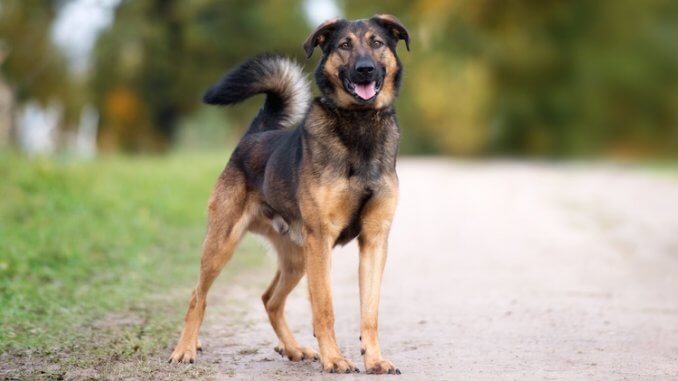
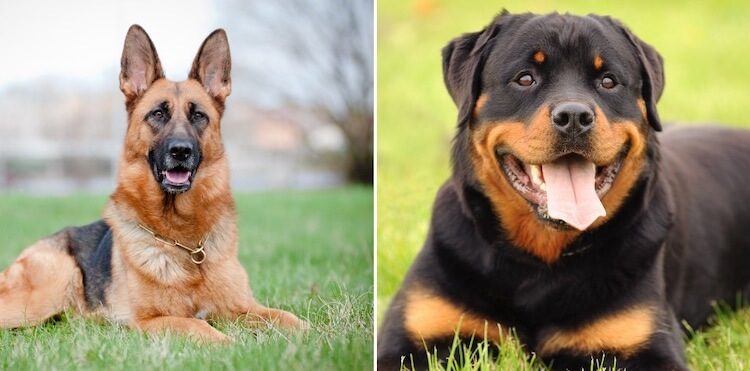
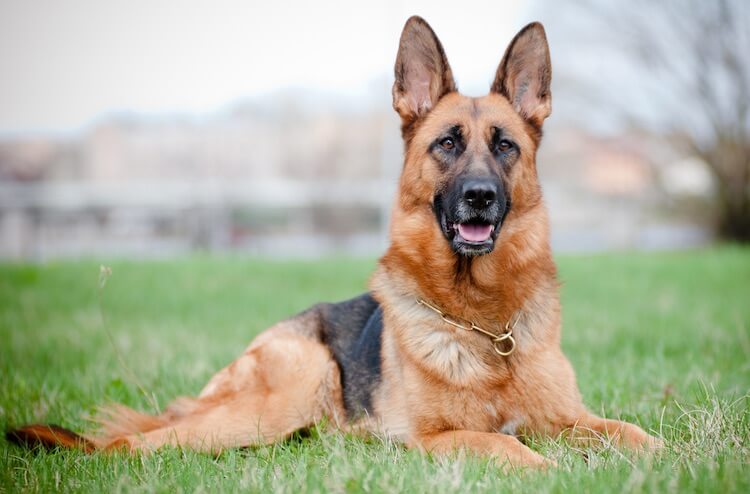

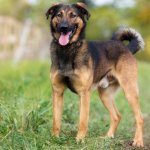
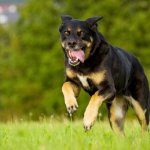
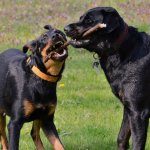

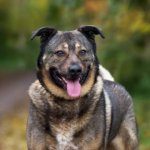
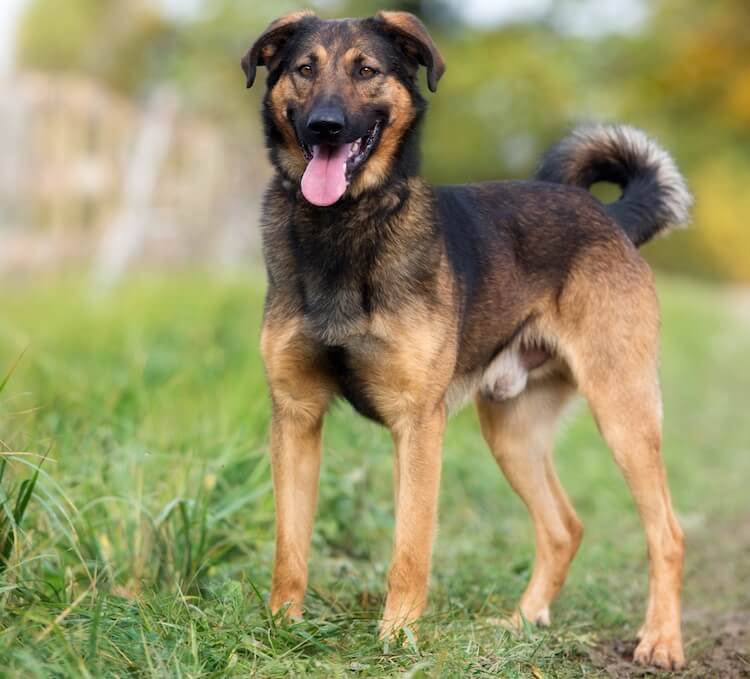
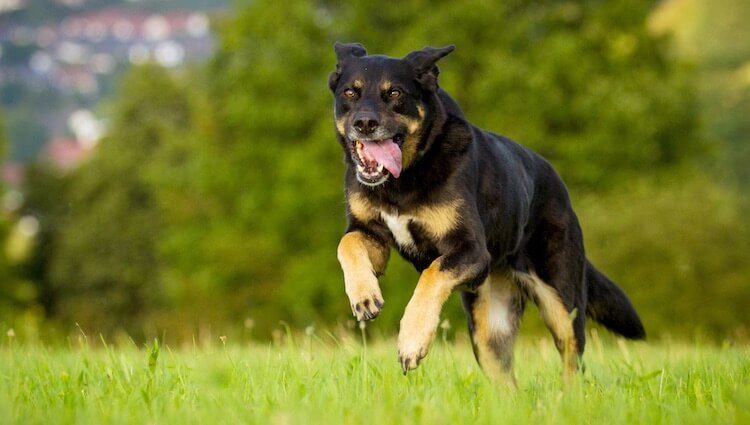
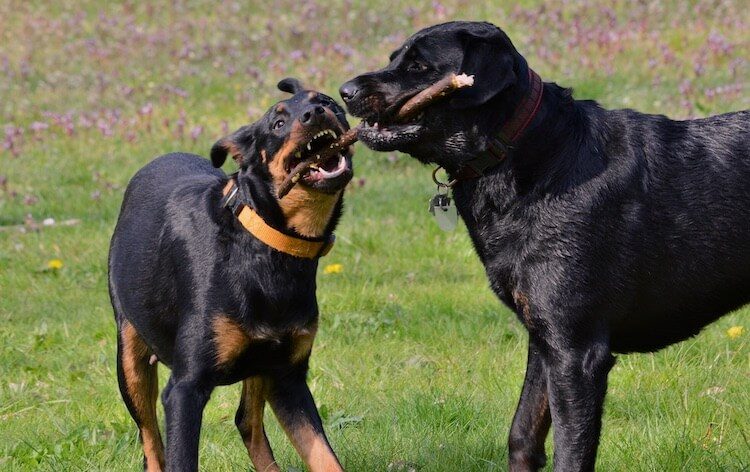

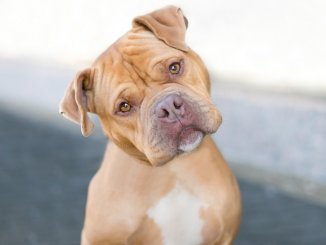
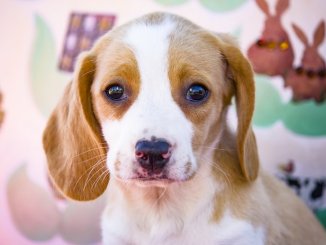
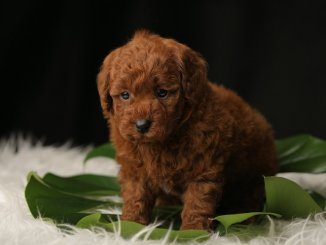
I’m a proud owner of a Rotti-Shepherd and couldn’t ask for a more loyal and loving dog. She has an amazing temperament as my 4yr old son pulls her ears, jumps on her and pokes her, but she adores him. It took a while but she’s great off the lead and her recall (if she hasn’t found a squirrel) is brilliant. A true joy as a family pet and a happy dog is a loveable dog.
I am currently looking for one of these mix breed dogs and I am having NO luck finding one. Does anyone know a breeder?
Yes I have this bread.
My husband and I adopted our Rotten Shepherd when he was about 8 months old, he just turned 2 this July. He is such a loving and loyal dog! He is great with our 3 daughters and other young family members. Unfortunately, when we adopted him we learned that he was abandoned when the shelter found him so it has taken a lot of patience and training to get him to understand commands. So if you adopt this breed a little later on, be prepared to put in the work. Also, make a priority to socialize this breed as early as possible because our dog is very territorial when most house guests come over, to the point we’re having to seek an in home trainer. But above all else, I love our furry little guy! Definitely recommend to anyone looking for a wonderful companion.
We are looking for a female Rott/Lab mix puppy. We have had two others and love the mixed breed. Please contact me if there are any available in Northern California. Thank you.
I adopted two Rottie-shepherds when they were 3 months old. They are the most amazing dogs ever. Prior I had my German Shepherd for 9 years before he passed so I needed a best friend and left the shelter with two. Every morning they wake me up for their daily run and they play with each other before work. They are now 7 months old and I have to say they are loyal and obedient. They are great with my 8 year old son. And have converted my husband to a dog lover.
Thoughts on benefits or drawbacks of neutering a male Shepherd-Rottweiler at 1 and 1/2 years old?
Hi Maureen,
This is a huge debate and ultimately, it’s personal preference. There are new schools of thought suggesting that unless males are exhibiting problematic “male” behavior, there is little evidence that supports castration. For large breeds, it is argued that they shouldn’t be neutered until they are fully grown, as their hormones tell their body when to stop growing. Studies have shown that early neutering has resulted in taller dogs, which isn’t necessarily great for skeletal development, especially in those prone to orthopedic issues. Leaving them in tact can lead to issues around local females in heat, so management of this does need to be considered. There is also little agreement over the idea of increased aggression in in-tact males. It’s not an easy decision, but there is plenty of research out there.
Have a female shottie, like that name. Great dog we had issues when we first got her. But she’s the best now. Very exitable when we go for walk. I wonder how protective they are to owners